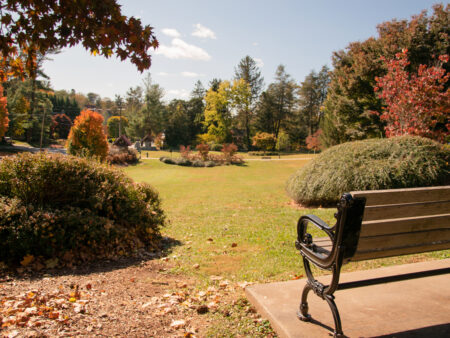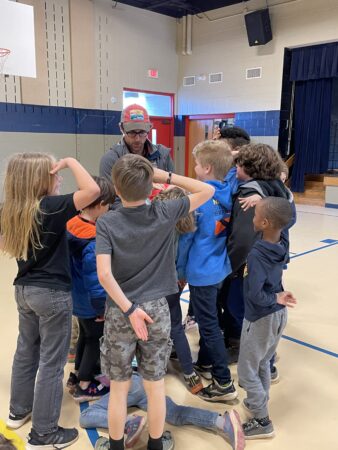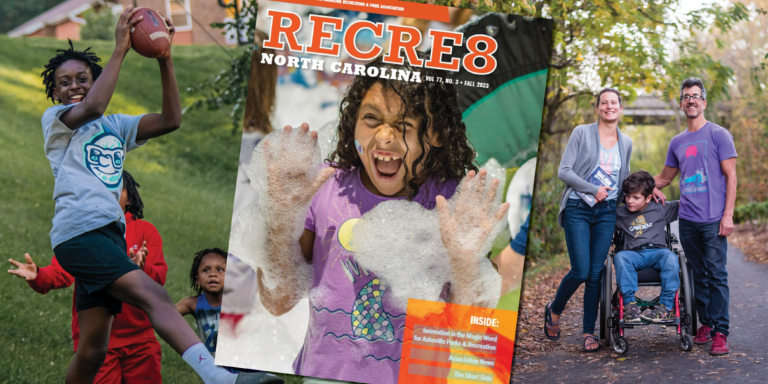Recre8 North Carolina, the quarterly magazine for members of North Carolina Recreation and Park Association, spotlights Asheville Parks & Recreation (APR) in a feature-length cover story for its latest issue. Mailed to more than 3,000 parks and recreation professionals throughout the state, the article focuses on APR’s use of innovative solutions to respond to Asheville’s unique challenges and opportunities, as well as the Recreate Asheville comprehensive plan. Full text of the article is below and can also be read as a flipbook multimedia magazine.
Innovation is the Magic Word for Asheville Parks & Recreation
Ashevillains are in for some heavy lifting, but D. Tyrell McGirt thinks they’re up for it.
“We want to be the state’s center for parks and recreation innovation — and we want community members to challenge the department, join us, and be an integral part of the journey,” says the director of Asheville Parks & Recreation (APR). “It’s a bold goal, but it’s the mindset of our team. We believe our city deserves fresh solutions to common challenges, solutions that come from unlocking the modern power of parks and recreation.”
Asheville’s Front Porch
With parks that date to the 1890s when Asheville was the third largest city in North Carolina, city government began providing organized recreation services in 1933 under the direction of its Public Works Department. In 1945, a year-round recreation program was instituted and APR became a stand-alone department in 1956. Today, APR manages a unique collection of more than 70 public parks, eight fully-programmed community centers, and 10 miles of paved greenways.
 “Innovation has no precedent, but our organization does have a history,” D. Tyrell continues. “We are building on the creativity and hard work of our predecessors, not just looking from the present forward. Our department is very old, which means looking at policies, procedures, and programs that were built years and even decades ago through a modern equity lens. APR’s focus is building on wins and learning from misses to create a strong, healthy, and happy place to live.”
“Innovation has no precedent, but our organization does have a history,” D. Tyrell continues. “We are building on the creativity and hard work of our predecessors, not just looking from the present forward. Our department is very old, which means looking at policies, procedures, and programs that were built years and even decades ago through a modern equity lens. APR’s focus is building on wins and learning from misses to create a strong, healthy, and happy place to live.”
When D. Tyrell arrived in January 2022, the city’s new Community and Regional Entertainment Facilities department absorbed Asheville Municipal Golf Course, Aston Park Tennis Center, McCormick Field, and Western North Carolina Nature Center into a department that also includes a civic center, Harrah’s Cherokee Center – Asheville. The change allows APR to maintain focus on community recreation at the neighborhood level.
“Parks and recreation is the front porch of municipal services,” adds D. Tyrell. “A visit to a park, attending a festival or special event, taking part in an exercise class, a walk on a greenway. These are often the first time people experience a real sense of what our community is about. Those of us who work for the department also live in this community and want to use every connection, insight, and bit of knowledge we have to make sure everyone feels welcome, included, and at home in APR spaces. Our team builds trust and preserves local culture because this is the place we call home.”
To sharpen that focus, the department took a look at its communications strategy, refreshed its logo, and made better use of its marketing toolbox. Getting the word out means photo-heavy social feeds, bus advertisements, podcast interviews, and tried-and-true outlets like program guides (available in English and Spanish), banners in parks, and yard signs to meet community members where they spend free time.
“When you think about paying taxes or your water bill, who will pick up your trash and recycling, and other services that your municipal government is expected to provide, residents don’t have much of a choice,” says Christy Bass, Business Resources Division Manager. “Asheville is full of recreation options, particularly those that take place outdoors. Our primary goal is to provide low- or no-cost opportunities for our community. For some people, that implies they’re inferior, but our city is rediscovering what APR offers is often better quality than high-priced competitors whether it’s outdoor recreation, afterschool programs, adult sports, or any of the hundreds of programs we offer each month. Developing a consistent, recognizable, and fun brand translates to trust in the information we share with a community that is often skeptical about government communication.”
Top Talent
The focus on innovation also means recruiting and fostering talent throughout the department. The asset management division, responsible for maintenance and upkeep that ensure parks and community centers stay safe and clean, hires team members with expertise in specialized fields like sports turf management and aquatics. It’s also not uncommon for someone from asset management to move into programming work in the recreation division. In the past year, nine staff members earned their CPRP credentials for the first time.
“Asset management is key to day-to-day operations, even though we like to stay behind the scenes,” according to John Shaw, Assets Program and Operations Manager. “Staffing capacity has been a challenge that is easing somewhat. Recently, we consolidated our crew from multiple locations around the city to one location which has built teamwork accessibility and reduced APR’s carbon footprint. Having a fairly centralized base of operations for all our employees has cut down on the amount of added trips to gather equipment and supplies from multiple areas. We have also been able to rethink some of our maintenance routes and find the most efficient schedule to get our tasks performed in a timely manner.”
The move came with staff restructuring to better use resources over four 10 hour shifts, utilizing available equipment and allowing more team member visibility in parks during later hours. In addition to consolidating campuses, all asset managers are completing their second year of National Recreation and Park Association Oglebay Maintenance Management School and are CPRP and Aquatic Facility Operator (AFO) certified. Applicable supervisors also receive credentialed training in integrated pesticide management, turf management, and playground safety inspection.
Community Driven Recreation
 “I grew up across the street from Malvern Hills Park,” says Aundreas Hill, a community center program leader. “Having the pool and park close by was something I enjoyed as a kid. Now, I have the opportunity to go back and help my community. I also have the opportunity to add programs for young people and adults – and that’s a great feeling.”
“I grew up across the street from Malvern Hills Park,” says Aundreas Hill, a community center program leader. “Having the pool and park close by was something I enjoyed as a kid. Now, I have the opportunity to go back and help my community. I also have the opportunity to add programs for young people and adults – and that’s a great feeling.”
Aundreas is not alone. Giving back to the community is a recurring answer when APR team members are asked why they work for the department. It’s not a responsibility they take lightly.
“It means the world to me that we provide fun, safe, and innovative recreation opportunities to community members with disabilities in a compassionate and accepting environment,” adds Lori Long, Therapeutic Recreation Manager. “I’m proud to tell folks where I work.”
Asheville has a well-earned national reputation as a laid-back retreat in the North Carolina mountains. Closer to home, it’s also known for passionate community members who are exceedingly protective of their recreation spaces and parks.
Much of APR’s portfolio was built during a period of rapid expansion between the late-1970s and mid-2000s. Community members feel a sense of personal ownership as they helped plan and build these spaces or have cherished memories of ball games, summer camps, and family reunions. Three of the city’s community centers are located in buildings that served Asheville’s Black families during government-mandated school segregation and a handful of parks were developed during the urban renewal era, representing a promise to the city’s Black legacy neighborhoods.
That’s where the heavy lift comes in. This fall, APR asks residents to unlock the power of community by building the Recreate Asheville plan to guide parks, community centers, and recreation spaces for future generations.
Recreate Asheville
Unfortunately, APR’s period of rapid expansion didn’t come with a corresponding preservation budget. Aging facilities and a long list of deferred maintenance reached a point in which voters approved a $17 million bond referendum in 2016 to support major improvements to five facilities, acquire nearly 11 acres for a new park, and improve outdoor courts, playgrounds, and sports fields throughout the city. The department developed its first equity action plan to rank neighborhood investment projects and community programming.
“When we say we want to be the center for parks and recreation innovation, that means incorporating equity as a major guiding principle to create a just, fair, and inclusive system tailored to meet the unique needs of our community,” says Candy Hensley-Shaw, Recreation Division Manager who has been with APR for over 25 years. “It’s understood that parks are adaptable infrastructure that make our community more resilient in the face of natural disasters and climate change, preserving the area’s natural beauty and well-being of close-knit neighborhoods. What’s harder for some people to understand is that Asheville is a safer and better place when everyone has the opportunity to be supported, healthy, and successful. Asheville’s future leaders thrive in afterschool programs, sports, summer camps, mentorships, and youth and teen programs that are critical to foster imagination and creativity, teamwork, emotional stability, mutual trust, and environmental responsibility.”
 APR’s current comprehensive plan was published in 2009, before many community members were plugged into local government. The department thinks that level of awareness and participation provides a solid foundation for the Recreate Asheville plan.
APR’s current comprehensive plan was published in 2009, before many community members were plugged into local government. The department thinks that level of awareness and participation provides a solid foundation for the Recreate Asheville plan.
“Thankfully, our community already feels comfortable offering suggestions and doesn’t wait for us to come to them,” according to Pete Wall, APR Assistant Director. “We receive regular phone calls, emails, direct messages through social channels, requests through online forms and the Asheville App, and face-to-face feedback. Our focus is making sure the Recreate Asheville plan is the right plan for this point in time, achievable and adaptable over the next 10-15 years.”
D. Tyrell describes the Recreate Asheville plan as more than a comprehensive planning document. “It’s a way for us to collect the vision and values of the people who use our services,” he says. “We can inventory our parks and quantify the number of programs we offer, but this is a chance to incorporate the emotional connection Ashevillains feel about these treasured spaces, their ideas to keep them safe and welcoming for all, and the power of memories made within them.”
Ultimately, the plan should continue to build on the trust established between APR and the often-skeptical community members, establishing more sense of ownership and connection. While it won’t be the final heavy-lift request the department offers its city, it marks an exciting new chapter for a department embracing its tagline: Explore. Connect. Discover.
